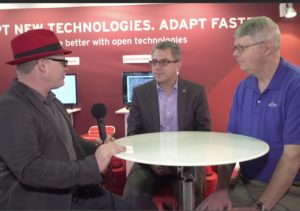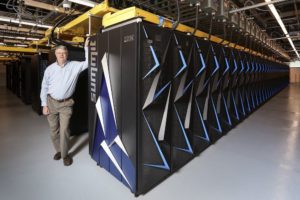 In this video from ISC 2018, Yan Fisher from Red Hat and Buddy Bland from ORNL discuss Summit, the world’s fastest supercomputer. Red Hat teamed with IBM, Mellanox, and NVIDIA to provide users with a new level of performance for HPC and AI workloads.
In this video from ISC 2018, Yan Fisher from Red Hat and Buddy Bland from ORNL discuss Summit, the world’s fastest supercomputer. Red Hat teamed with IBM, Mellanox, and NVIDIA to provide users with a new level of performance for HPC and AI workloads.
Using standard CPUs from IBM, GPU accelerators from NVIDIA, Infiniband networking from Mellanox, and a standard Linux operating system from Red Hat in Red Hat Enterprise Linux, this system is a result of a multi-year collaboration and highlights a convergence between esoteric and mainstream technologies.
The composition of Summit should not come as a surprise, as modern supercomputers are frequently built from a collection of components that each meet specific needs, rather than using the product line of a single vendor. All of these components are commoditized, in that they can be (and often are) deployed into enterprise datacenters. Also like traditional datacenters, running on this hardware are often Linux distributions – according to the most recent (November 2017) Top500 list, the top ten fastest supercomputers in the world all run a variant of Linux.
The total system design of Summit, consisting of 4,608 IBM compute servers, aims to make it easier to bring research applications to this behemoth. Part of this is the consistent environment provided by Red Hat Enterprise Linux, with which many leading researchers around the world are already familiar. Red Hat Enterprise Linux is also widely deployed in National Labs and research centers around the globe and is a proven platform for large-scale computing across multiple hardware architectures.
Summit uses a new building block-type architecture that supports a wide range of applications, from astrophysics, to material science, to human systems biology. All of which could be augmented by enhanced AI/ML (Artificial Intelligence and Machine Learning) capabilities, making it a truly “intelligent” machine.
 Each of Summit’s building blocks include: two IBM POWER9 processors, six NVIDIA Volta V100 GPUs, 512 GB memory, local NVMe storage, and Mellanox Infiniband. A critical part of developing Summit was the close cooperation between all of the partners, beginning with the early enablement of POWER9 CPU in Red Hat Enterprise Linux, then collaborating with NVIDIA on GPU integration, tying the system together via Mellanox interconnect, and, finally, making Summit accessible to end users through the common interface of the operating system provided by Red Hat.
Each of Summit’s building blocks include: two IBM POWER9 processors, six NVIDIA Volta V100 GPUs, 512 GB memory, local NVMe storage, and Mellanox Infiniband. A critical part of developing Summit was the close cooperation between all of the partners, beginning with the early enablement of POWER9 CPU in Red Hat Enterprise Linux, then collaborating with NVIDIA on GPU integration, tying the system together via Mellanox interconnect, and, finally, making Summit accessible to end users through the common interface of the operating system provided by Red Hat.
The experience of running 12 leading science applications on Summit as part of the Oak Ridge Early Science program demonstrates the power of the new design in making high performance readily available to researchers. These Early Science results suggest that, Summit is proving to be flexible in hosting a wide range of scientific and technical workloads and has shown to be effective in supporting the next-generation of supercomputing workloads through AI and Machine Learning capabilities.
But the rapid innovation showcased by Summit must be consumable, and that’s where Red Hat Enterprise Linux comes in. Despite the scale, processing capability, and “intelligence” of Summit’s composition, end users interact with something they understand: Linux, in the form of the world’s leading enterprise Linux platform. Red Hat Enterprise Linux provides a common, stable basis that ties together all of this innovation.
Summit is a current paradigm for technology innovation at scale, but underneath it all, Linux brings it all together. Red Hat is proud to have helped bring Summit to life, and we stand ready to support and collaborate on the future waves of supercomputing and enterprise IT innovation, no matter what they might be.




